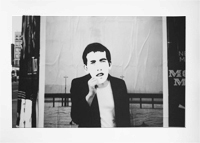In the post-everything era, whose advent coincided with the rise of digitization in photography, it has often seemed, paradoxically, as if nothing new can be done. The negative consequence of this is that contemporary photographs can look a lot like vintage ones; the positive outcome is that new and intriguing connections are often made between past and present. Luckily, there are many examples of the latter at the AIPAD Photography Show New York.
At the entrance of this Association of International Photography Art Dealers show at the Park Avenue Armory is a body of work that uses traditional portraiture techniques to represent a distinctly current event. “Occupying Wall Street” by Accra Shepp, and presented by Steven Kasher, is a grid of black-and-white photographs featuring people in Zuccotti Park, from young protesters holding cardboard signs to an older, elegant couple posing with their well-groomed dog. But the series resonates with earlier social documentary photography, like the civil rights photographer Ernest C. Withers’s “I Am a Man March, Sanitation Workers, Memphis” (1968), a print of which is also at Kasher.
More documentary photography is at Daniel Blau, including an extraordinary contact sheet of large aerial photographs taken with a geographical survey camera by the United States military two days after the bombing of Hiroshima. At 798 Photo, a Beijing gallery that is a newcomer to the fair, a large black-and-white photograph from 1974 by Wang Shilong shows hundreds of workers digging a dam on the Red Flag Canal in China during the Cultural Revolution.
The last decade has seen an efflorescence of abstract and experimental photography, much of it harking back to modernist investigations. The Finnish artist Niko Luoma’s “Symmetrium” (2010) at Bryce Wolkowitz is a swirling, abstract, color Diasec print made by taking hundreds of exposures with a camera in his studio. But you can see earlier abstractions, like a 1935 photogram by Laszlo Moholy-Nagy at Howard Greenberg or a 1938 photogram recalling Man Ray by the lesser-known but wonderfully inventive Gyorgy Kepes at Joel Soroka.
The contemporary British photographers Susan Derges, Christopher Bucklow and Garry Fabian Miller, on view at Danziger, specialize in cameraless photography. Mr. Miller’s dye destruction prints of flower petals, created by shining light through an enlarger, conjure a particularly famous precedent: Henry Fox Talbot’s photogenic drawings of botanical specimens, an example of which, from around 1839, can be seen at Hans P. Kraus Jr.
Also at Danziger are works by the Japanese artist Yuji Obata, who is credited as the first person to microscopically photograph falling snowflakes. Mr. Obata’s continuing series, “Homage to Wilson A. Bentley,” started in 2005 — after five years of experiments — honors the American who first captured stationary snowflakes under a microscope in the 1880s.
Nature vacillates between abstraction and representation in the recent photographs of Matthew Brandt, on view at Yossi Milo and M+B. Part of Mr. Brandt’s process involves soaking his prints in water from the lakes he photographs, which results in blurry passages in the final images. Other landscapes verging on abstraction are Edward Burtynsky’s aerial photograph “Dryland Farming” at Bryce Wolkowitz, which was taken in Spain as part of a series investigating the global water crisis, and Victoria Sambunaris’s stark image of a copper mine from 2002 at Yancey Richardson.
“East of Eden,” a new series by Philip-Lorca diCorcia at David Zwirner, also looks at landscape through a fatalistic lens. According to a gallery release, Mr. diCorcia cites the Book of Genesis — that is, the fall of humanity — and the end of the George W. Bush era as sources for his eerily lighted scenes of the American West. Mr. diCorcia’s images also look back, however, to modernist images by Ansel Adams, Brett Weston and Harry Callahan, on view throughout the fair.
Much of the work in AIPAD would be described as art rather than vernacular photography, although Charles Schwartz has a nice selection of commercial studio portraits from the 19th century. But a subcategory of images might be identified as photography about art. This includes Nickolas Muray’s 1939 photographs of Frida Kahlo at PDNB — including one of Kahlo posing with a paintbrush and palette before a double self-portrait — and Constantin Brancusi’s amazing photographs of his own sculptures at Silverstein.
It also includes Emily Roysdon’s works at Higher Pictures, clever re-creations from 2001 to 2007 of a late-’70s David Wojnarowicz project in which he photographed himself around downtown Manhattan, his face obscured by a photo-portrait of the poet Arthur Rimbaud. (Ms. Roysdon substituted a photograph of Mr. Wojnarowicz’s face.) At Kopeikin you can see Chris Jordan’s 2011 photographic re-creation of van Gogh’s “Starry Night,” made with 50,000 cigarette lighters, and Andy Freeberg’s “Marlborough” (2010) from his “Art Fare” series.
In Mr. Freeberg’s photograph — named for one of New York’s blue-chip galleries — two men in suits stand before a black monochrome painting by the American modernist Ad Reinhardt. What are they talking about, you wonder? “Money,” Paul Kopeikin speculated.
This might be the reigning topic among some AIPAD visitors. But the show also leaves room for making other connections and discoveries.
The AIPAD Photography Show New York runs through Sunday at the Park Avenue Armory, 643 Park Avenue, at 67th Street; aipad.com.
More information available at: http://www.nytimes.com/2012/03/30/arts/design/aipad-photography-show-new-york-at-park-avenue-armory.html

